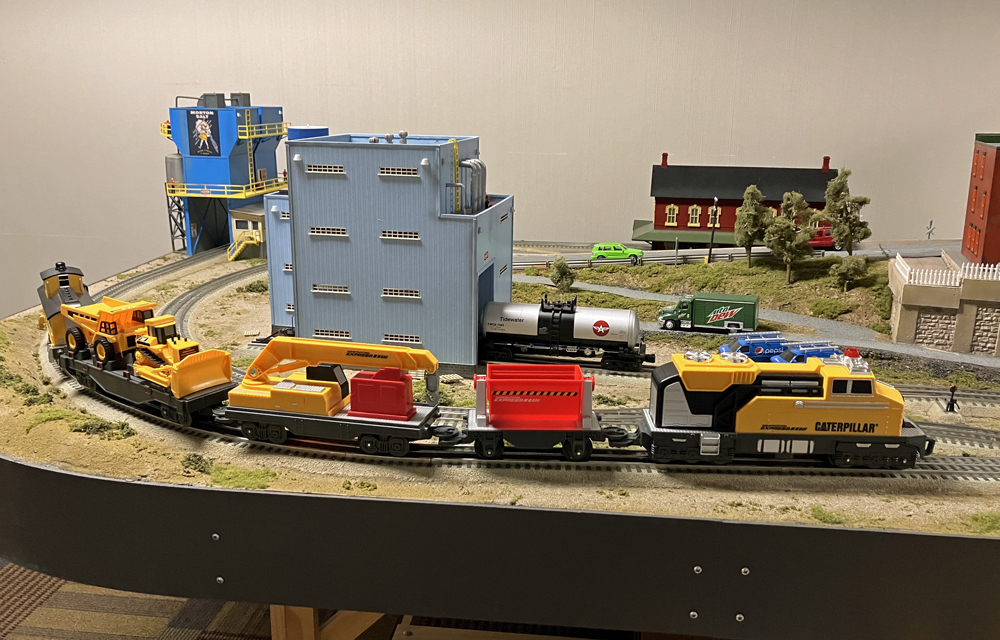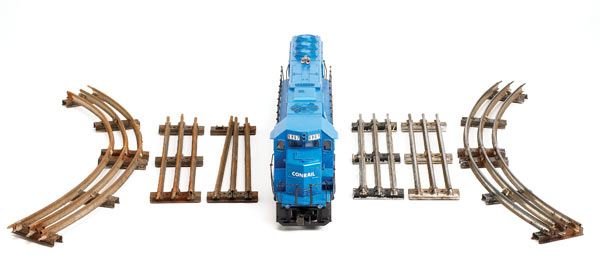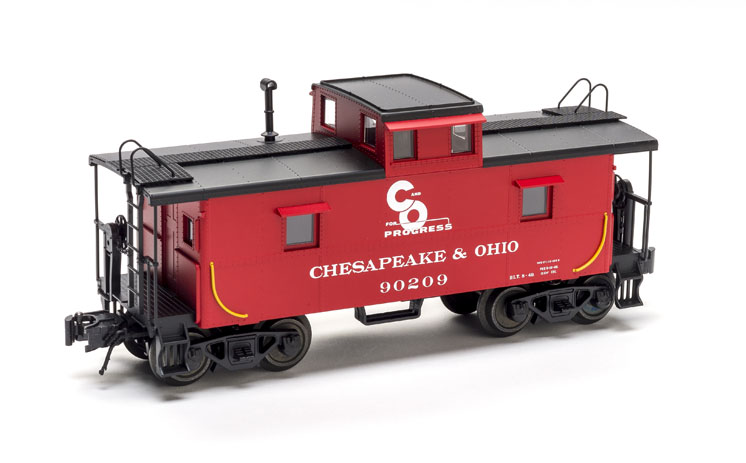The sight of a toy train locomotive puffing across a layout, its rhythmic white exhaust reaching out to the sky, is as captivating today as it was when the first smoking O gauge locomotive debuted more than 50 years ago.
But what you see isn’t smoke. There is no combustion occurring. Without combustion, you can’t have smoke. So what is the cloudy haze?
Would you believe a fog?
How it works
In modern toy train smoke units, a heating element inside the locomotive vaporizes the smoke fluid, which is a lightweight oil that varies in viscosity depending on the brand. When the vapors come into contact with cool air, they condense to form a colloid that consists of liquid droplets dispersed in air – in other words, a fog. Meteorological fog forms the same way when warm, moisture-laden air moves into cooler territory.
Colloids tend to stay suspended in air because each particle has some static electric charge. Since the particles are small and each of them repels the others, they do not quickly settle.
Colloids look “smoky” because the suspended particles are large enough to scatter light. The classic test for recognizing a colloid is the ability to see the path of a light beam shining through it.
This is called the Tyndall Effect. A familiar example is a searchlight beam probing the sky at night, like in the beginning of a 20th Century Fox movie. The light beam would be invisible if it were passing through clean, dry air, but becomes visible when particles of dust, smoke, and moisture reflect the light.
Whether Lionel’s catalog artists realized it or not, the beam from the headlights of postwar Lionel locomotives depict the Tyndall Effect. There must have been a lot of air pollution in Lionelville!
Solid and liquid
Lionel was the only company to develop and market a solid smoke pellet. All but the pellets produced in 1946 were made from a secret waxy compound called meta-terphenyl. A. C. Gilbert and Marx always used smoke fluid. Lionel began using smoke fluid in 1957, and today, owners of postwar smoke-pellet locomotives often convert them to use smoke fluid.
Manufacturers seldom specify the exact chemical properties of their smoke fluids, but the fluids associated with Lionel, MTH, K-Line, and Williams are all oils of varying viscosity. Manufacturers tend to recommend only certain fluids in their smoke units, which likewise vary slightly in design from one train maker to another.
While the smoke-unit principle remains the same, modern manufacturers have made vast improvements aimed at realism. Output, for one, is greatly increased. Some locomotives use built-in fans to drive the “smoke” out the stack. Electronic controls can also synchronize the exhaust rate to the train’s speed and sound system. Some locomotives are designed to allow “steam” to appear in other places that steam tended to escape on real locomotives. Recent diesel locomotives also use liquid smoke units.
Second-hand smoke
Is this toy train pseudo-smoke harmful to your health?
Well, a jar of pure meta-terphenyl is labeled an “irritant,” meaning that chronic exposure can irritate the eyes, skin, and mucous membranes. Some chemical substances in smoke fluid can also be moderate eye irritants and slight irritants to mucous membranes.
Common sense suggests that hobbyists provide themselves with at least some ventilation in their train rooms and that they find some fresh air if they experience headaches, sore throats, eye irritation, or itching skin after standing in a cloud of toy train “smoke.”
Alarming possibility
Can the “smoke” from your toy train trigger a smoke alarm? The answer is qualified yes, if enough of it reaches the detector.
Two types of smoke detectors are sold for home fire protection. In the first, a photoelectric detector shines a beam of light through an air channel and is activated if something in the air is opaque enough to obstruct the beam. In the second, an ionization detector contains a tiny radioactive source (usually americium 241) that emits alpha particles, which ionize air and allow a current to pass. This type of detector is tripped when something interrupts the current.
Toy train “smoke” can activate either type of smoke detector because the colloidal particles reflect light and because they interfere with ionization current. However, you might have to bring your smoke detector down to trackside to trigger its warning buzzer. Toy train smoke seldom rises to the ceiling because it is cooler and therefore denser than the combustion smoke produced by a real fire.
By any other name
That toy train smoke is truly a fog isn’t all that important. What’s important is the image it conveys. Billowing clouds of “smoke” from a steam locomotive rumbling down the track are part of the toy train scene. It’s hard to imagine toy trains any other way, even after half a century of innovation.
The Secrets of Lionel’s Smoke Pellets
After World War II, Lionel and A. C. Gilbert raced to be the first to offer smoking steam locomotives. Gilbert’s American Flyer trains beat Lionel to the punch by a period of days in announcing its first smoking locomotive in 1946. Smoke research at both companies was shrouded in secrecy, and the makeup of Lionel’s smoke pellets remained a mystery for decades.
Four strikes
Lionel’s first smoke unit, designed by chief engineer Joseph Bonanno and used on three locomotives in 1946, was short-lived for a number of reasons.
First, the specially shaped headlight bulb that heated an ammonium nitrate pellet below the smokestack was somewhat fragile and relatively expensive to manufacture. Second, during operation the entire pellet melted at once, and if the locomotive were turned upside down, molten material would spill out. (Ammonium nitrate melts at 338°F.)
Third, the spilled ammonium nitrate – a salt that’s a member of the same chemical family as the sodium chloride used to melt ice in winter – corroded the inside of the locomotive. Think of the rust damage done to your automobile by road salt and then imagine how much more destructive it would be at oven temperatures.
And fourth, perhaps the most compelling reason for Lionel to reinvent the smoke unit, may have been a shipping disaster on April 16, 1947. The French ship Grandcamp, loaded with 2,300 tons of ammonium nitrate, exploded at its dock in Galveston Bay near Texas City, Texas. The blast flung the ship’s 1.5-ton anchor more than two miles, sent a mushroom-shaped cloud 2,000 feet into the air, knocked two aircraft out of the sky, generated a 15-foot tidal wave that drove a 30-ton barge 100 feet inland, and caused a second disastrous explosion the next morning. Altogether 563 persons died and over 3,000 people lost their homes.
Thereafter, Lionel or any toy company would hardly dare to market “harmless” smoke pellets made of ammonium nitrate.
Try, try again
Back at Lionel, Frank Pettit, the firm’s development engineer, designed a new smoke device, smaller than the first one, that consisted of a resistance-wire heater plus a piston that blew puffs of air in rhythm with the locomotive’s wheels.
Meanwhile, Mario Mazzone, a Lionel chemist, searched for a substance that would vaporize easily in the heater then condense into a white cloud when it contacted cool air. He eventually settled on a white, waxy solid compound. Mazzone purified the compound in his kitchen, pressed it into tiny pills, and dried them on trays spread on his dining room table. After successful tests, Lionel rushed the new smoke unit into production.
Despite this success, Mazzone was uneasy. Lionel would eventually get the patent for the smoke unit in 1953, but what was in it for him?
To protect himself, Mazzone never told anyone what was in the smoke pills. Eventually he went into business for himself under the name of Azo Industries, manufacturing the pellets but still never revealing their ingredients, even to his employees.
Mazzone supplied smoke pellets to the Lionel Corp. until the end of the postwar era, then sold his business to General Mills’ MPC when it began making Lionel trains in 1970. Smoke pellets (item no. 2911) were available until 1973.
Mystery solved
Exactly what was inside those waxy pills remained a mystery for nearly 30 years. In 1975, a curious chemist and toy train fanatic – Dr. Herbert C. “Chip” Miller, then employed at Southern Research Institute in Birmingham, Ala. – took it upon himself to solve the mystery.
Through testing, Miller discovered that the pellet was made of meta-terphenyl, a white, waxy solid that was used primarily as a coolant/electrical insulator in high-voltage transformers.















Smokin’ article! Thanks for sharing your wealth of knowledge on the subject.
Have used liquid smoke in the wire element units. Works fine. ONLY A FEW DROPS.
Is there information as to whether manufacturers have attempted to create darker smoke? Or is that even possible with the colloidal principle?
Great article. Dig a little deeper about the 1947 boat explosion and you’ll find some very interesting things about Texas City, especially Galveston.
I’ve successfully used smoke fluid in a postwar lightbulb smoke unit. The trick is to place fiberglass wadding under the bulb to catch any fluid spilling from the indentation in the bulb.
Very interesting, keep this type of information coming. Never heard of the 1947 boat explosion before.
Thanks
Baby oil (mostly mineral oil) also makes a rather pleasant smelling smoke fluid. It smells like baby powder. By the way, I have been known to set off the smoke detector in my home when running multiple smoking locomotives at the same time. This did not set well with my wife.
Very good article. Should have mentioned that putting the ammonium-nitrate spoke pellet into a conventional nichrome wire smoke generator will destroy it. Also, would be nice to know if you can add liquid smoke fluid to nichrome wire smoke generator. Is that safe? What else will work as a replacement for ammonium-nitrate for a smoke bulb generator?
Jim B
Wow & holly cow! That was both very interesting and very enlighting. Thanks. It is articles like this that makes CTT the best.